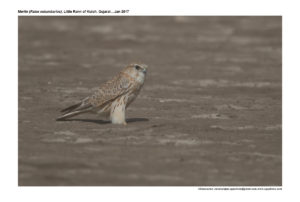
Merlin Falco columbarius
Etymology:
- Falco : Latin for Falcon based on Sickle shaped claws ( falcis- sickle)
- columbarius : Like Pigeon { colloquially called as a pigeon hawk in America}
Vernacular Names: Hindi: Daurela (M), Daurai (F), Pun: Retal turumti, Regi, Turmati, Mar: Hirvi Turmati
Distribution in India: Winter visitor in North India.
Description: Size of 25-30 cm. It is a distinctive small, stocky, dashing falcon. The male has upperparts dark or pale bluish, underparts from dark and heavily streaked to pale buff and lightly streaked; usually shows conspicuous narrow pale bands in tail. The female is browner, without blue tones; plumage generally more uniform, less contrasting than in male. Irides are dark brown, cere and feet yellow to rich yellow. Juvenile is similar to female but tends to have greenish-yellow to pale yellow cere and feet.
Habitat: It is found from sea-level up to treeline at 3000 m in some mountain ranges, from boreal forest and tundra to parkland with deciduous trees, shrub steppe, moorland, open prairies and steppes. Some trees or scrubby vegetation generally preferred, but always favours relatively open country and avoids dense forest.
Food Habits: During breeding season it eats small birds like Meadow Pipits, Skylarks, Wheatears, Common Chaffinches Starlings and Common Snipe. After breeding and during migration it eats some larger birds like sandpipers, bats and insects like dragonflies, locusts; well known for consuming dragonflies in flight on migration. Small rodents and shrews are also caught, especially by young in first year.It usually attacks from perch, but also while flying low over ground, and occasionally while hovering. Prey mainly caught in mid-air; attacks less frequently directed at perched birds; often performs hot pursuit of prey in flight. Sometimes hunts in company of other raptors, Pairs may hunt co-operatively. Prey flushed by other raptors and other objects like automobiles is also caught.. Food may be cached for later consumption.
Breeding Habits: They breed in Mar-June in Europe and America. The pairs are monogamous at least for a breeding season. No nest is built. It uses old stick nests of other species, especially corvids in trees; also uses tree-cavities, cliff ledges or stick nests on ledges; also on ground, usually in scrape within dense vegetation. Frequency of given nest type somewhat depends on region. It lays a clutch of 3–6 eggs . The incubation period is 28–32 days, by both sexes, with females typically performing majority of daylight duties. The chicks are born altricial. The fledging period is 28–32 days.
.